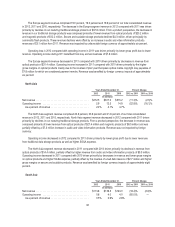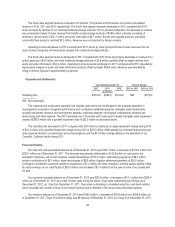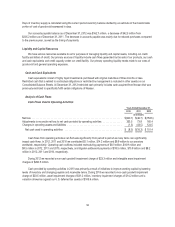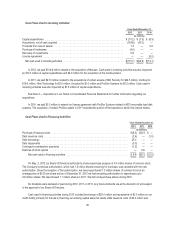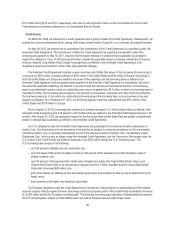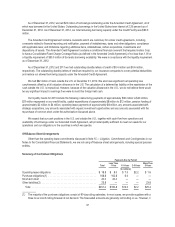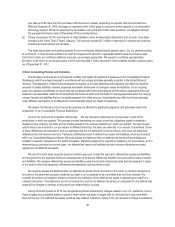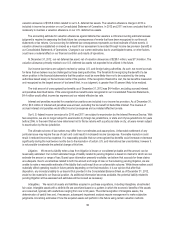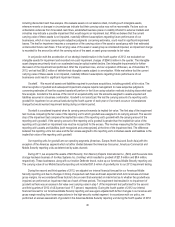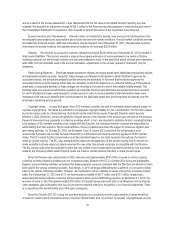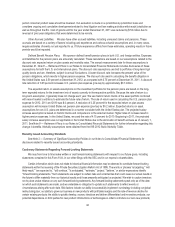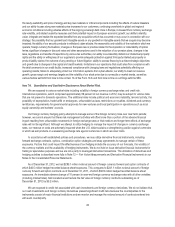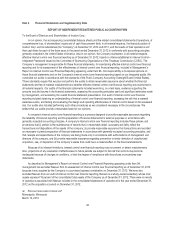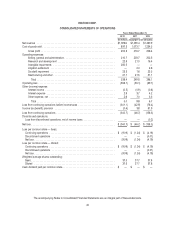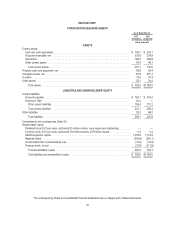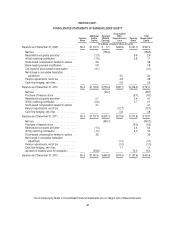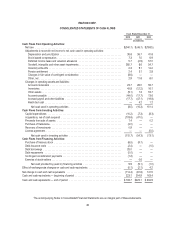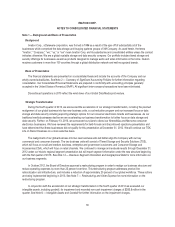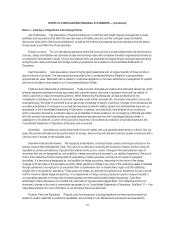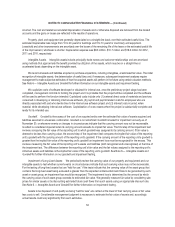Memorex 2012 Annual Report Download - page 45
Download and view the complete annual report
Please find page 45 of the 2012 Memorex annual report below. You can navigate through the pages in the report by either clicking on the pages listed below, or by using the keyword search tool below to find specific information within the annual report.period consumer product sales should be reversed. Our evaluation is made on a jurisdiction-by-jurisdiction basis and
considers ongoing and cumulative developments related to levy litigation and law making activities within each jurisdiction as
well as throughout the EU. Cost of goods sold for the year ended December 31, 2011 was reduced by $7.8 million due to
reversal of prior year obligations that were determined to be remote.
Other Accrued Liabilities. We also have other accrued liabilities, including uninsured claims and pensions. These
accruals are based on a variety of factors including past experience and various actuarial assumptions and, in many cases,
require estimates of events not yet reported to us. If future experience differs from these estimates, operating results in future
periods would be impacted.
Defined Benefit Pension Plans. We sponsor defined benefit pension plans in both U.S. and foreign entities. Expenses
and liabilities for the pension plans are actuarially calculated. These calculations are based on our assumptions related to the
discount rate, expected return on plan assets and mortality rates. The annual measurement date for these assumptions is
December 31. Note 9 — Retirement Plans in our Notes to Consolidated Financial Statements includes disclosures of these
assumptions for both the U.S. and international plans. The discount rate assumptions are tied to portfolios of long-term high
quality bonds and are, therefore, subject to annual fluctuations. A lower discount rate increases the present value of the
pension obligations, which results in higher pension expense. The discount rate used in calculating the benefit obligation in
the United States was 3.50 percent at December 31, 2012, as compared with 3.75 percent at December 31, 2011. A discount
rate reduction of 0.25 percent increases U.S. pension plan expense (pre-tax) by approximately $0.1 million.
The expected return on assets assumptions on the investment portfolios for the pension plans are based on the long-
term expected returns for the investment mix of assets currently in the respective portfolio. Because the rate of return is a
long-term assumption, it generally does not change each year. We use historic return trends of the asset portfolio combined
with recent market conditions to estimate the future rate of return. The rate of return used in calculating the U.S. pension plan
expense for 2012, 2011 and 2010 was 8.0 percent. A reduction of 0.25 percent for the expected return on plan assets
assumption will increase United States net pension plan expense (pre-tax) by $0.2 million. Expected returns on asset
assumptions for non-U.S. plans are determined in a manner consistent with the United States plan. The projected salary
increase assumption is based on historic trends and comparisons to the external market. Higher rates of increase result in
higher pension expenses. In the United States, we used the rate of 4.75 percent for 2010. Beginning in 2011, the projected
salary increase assumption was not applicable in the United States due to the elimination of benefit accruals as of January 1,
2011. See Note 9 — Retirement Plans in our Notes to Consolidated Financial Statements for further information regarding this
change in benefits. Mortality assumptions were obtained from the IRS 2012 Static Mortality Table.
Recently Issued Accounting Standards
See Note 2 — Summary of Significant Accounting Policies in our Notes to Consolidated Financial Statements for
disclosure related to recently issued accounting standards.
Cautionary Statements Regarding Forward-Looking Statements
We may from time to time make written or oral forward-looking statements with respect to our future goals, including
statements contained in this Form 10-K, in our other filings with the SEC and in our reports to shareholders.
Certain information which does not relate to historical financial information may be deemed to constitute forward-looking
statements within the meaning of the Private Securities Litigation Reform Act of 1995. The words or phrases “is targeting,” “will
likely result,” “are expected to,” “will continue,” “is anticipated,” “estimate,” “project,” “believe,” or similar expressions identify
“forward looking statements.” Such statements are subject to certain risks and uncertainties that could cause our actual results in
the future to differ materially from our historical results and those presently anticipated or projected. We wish to caution investors
not to place undue reliance on any such forward-looking statements. Any forward-looking statements speak only as of the date
on which such statements are made, and we undertake no obligation to update such statements to reflect events or
circumstances arising after such date. Risk factors include our ability to successfully implement our strategy including our global
restructuring plan; our ability to grow our business in new products with profitable margins and the rate of revenue decline for
certain existing products; the ability to quickly develop, source, introduce and deliver differentiated and innovative products; our
potential dependence on third parties for new product introductions or technologies in order to introduce our own new products;
42


